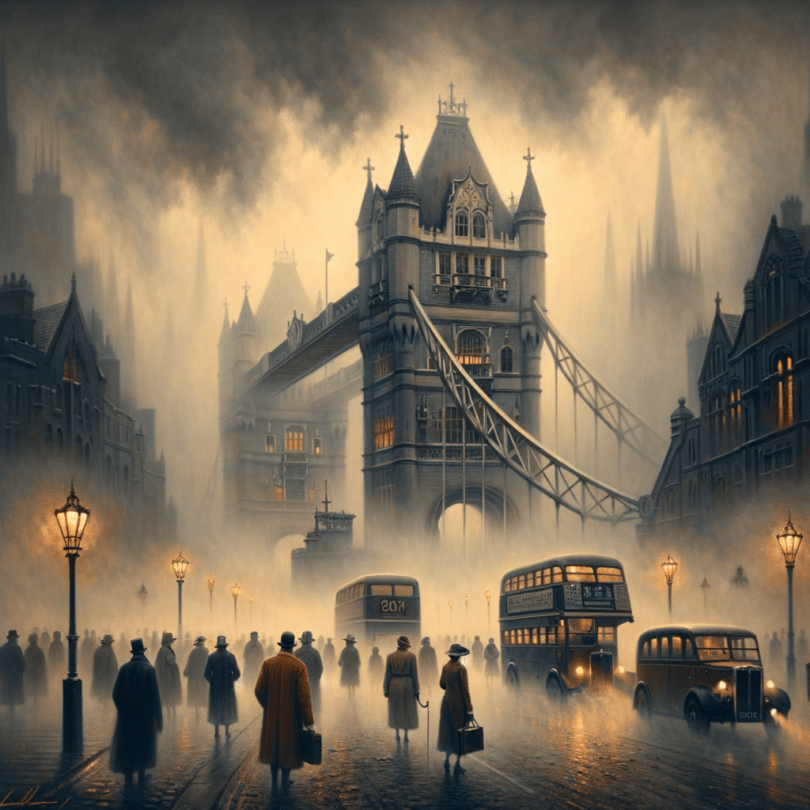As I sit here, warmed by a comforting cup of tea, my mind drifts back to a story shrouded in mystery and smoke. It’s December 1952, and London is swallowed by an eerie darkness that doesn’t quite make sense. It was the Great Smog, not just any ordinary mist. Oh no, this was a monstrous smog that decided to settle in, causing chaos and mayhem all over the city.
If you’re anything like me, when you think of a London winter, you might picture it in a vintage postcard with the freezing Thames and streets abuzz with folks wrapped in cozy scarves. But that December? Not even close! London was wrapped instead in a suffocating fog so thick you could barely see a foot ahead. Trying to get home in that mess? Forget it—you couldn’t even see your own hand!
What Really Happened?
So you might ask, what on earth happened to create such an otherworldly nightmare? Here’s the lowdown: London’s fogs were already famous, but this one was extra special courtesy of a climate snafu. The weather got super cold, people cranked up their coal fires to keep warm, and bam—out came all sorts of nasty stuff into the air. And as luck would have it, an anticyclone stopped by, trapping everything like a pot lid.
Oh, coal! It was post-war Britain’s lifeline, but it turned traitor, choking its own people. The smoke from homes, factories, and power plants mixed with the natural fog, cooking up a smog so gross it stung your eyes and throats. And let’s be real, air quality laws back then were pretty much useless.
The Human Toll
It breaks my heart thinking about those who suffered and lost their lives in that scary time. The smog crept into London like a villain, sneaking into homes and making breathing a risky business. Living in London, where the air can already be dubious on a normal day, I can’t even imagine the struggle back then.
At first, folks thought of it as a major inconvenience—sure, a troublesome one. But life went on, slowly and awkwardly, as public transport faltered. Can you picture a bus driver stepping out to guide the bus through the fog? Sounds like slapstick comedy, right? Except, it was a really grim reality.
As it dragged on, people realized it was a real deal disaster. Hospitals were flooded with patients wheezing for air, and sadly, lives were lost. It’s said around 4,000 people died directly due to this smog, and later studies suggest it could’ve been as high as 10,000. It’s gut-wrenching to think how fragile and trapped they must have felt in their own homes.
A City at a Standstill
Imagine the ever-bustling London brought to an awkward halt. Order fell apart, and chaos took over. Schools shut, sports games stopped, and theatres pulled their curtains, as you just couldn’t see a thing. Social outings must’ve been a comedy of errors—half guessing, half hoping to chat with the right person in the fog!
And then, the smog became a curtain for crime. The darkness gave thieves an easy time, adding another layer of fear and discomfort to a city already on edge.
Lessons Learned?
When I think about the Great Smog’s aftermath, it baffles me that it often takes such disasters for real action. Isn’t it human nature to learn the hard way? Post-smog, Britain woke up and smelled the reality, passing the Clean Air Act of 1956 to cut air pollution by managing coal use in cities. It was a needed step, but oh, how costly it was!
Today, the Great Smog is a stark reminder of that fragile line between human activities and nature. Ironically, the very actions meant to uplift and rebuild after the war triggered this calamity.
A Modern Perspective
Fast forward to now, where the world drums on about climate change and air quality—far cries from 1952 conversations. Science and tech have made strides for cleaner practices, yet history still whispers its cautionary tales.
We now have air quality reports and advisories, but modern-day challenges urge us to remain vigilant. We often take today’s cleaner air for granted without appreciating the tension beneath that keeps it so. On the hazy days, I think of those Londoners stuck in the smog—their vulnerability a lesson for a safer future.
The Great Smog seems a tale from long ago, but its echoes are loud in today’s voices. Here’s to appreciating the small wins, urging action and nurturing a cleaner environment. It’s a persistent endeavor, one I wish goes on long after my tea’s gone cold.
To remember those odd days when London wore its deadly cloak, not as just another history page but a call that bridges time—urging us to learn, evolve, and thrive wisely.

